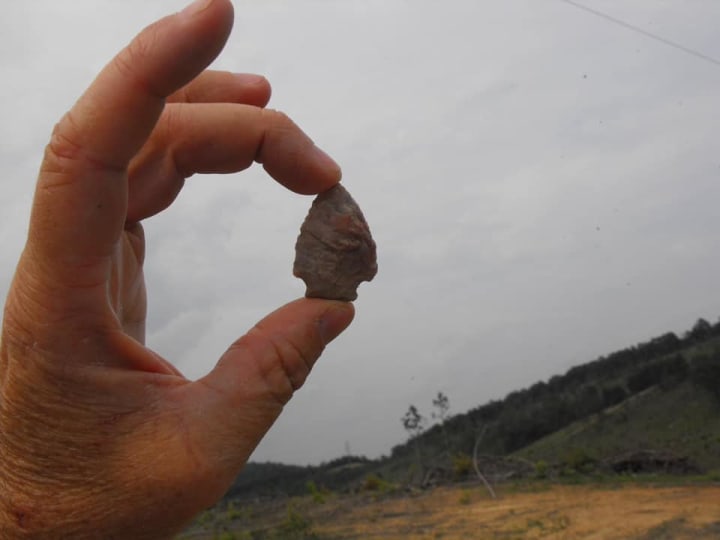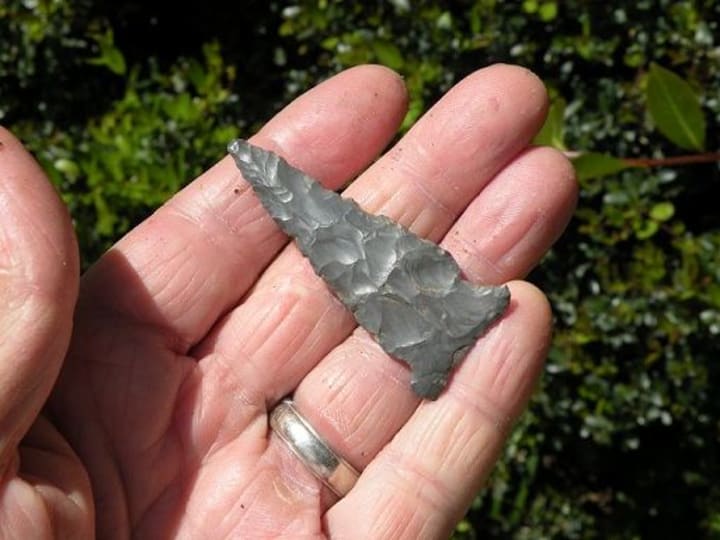How to Search for Native American Artifacts
Train Your Eyes to Spot the Material Native to Your Area and You Can Find Arrowheads.

Nobody knows with certainty even an approximate number, but when Columbus “discovered” America in 1492, it was heavily populated with Native Americans. They had been living on the continent for 13,000 plus years before Columbus landed in the New World. Most Native American artifacts are prehistoric. If you find an arrowhead, you are holding something that a human most likely left behind before the white man set foot in the Americas.

When Kathy and I began hunting Indian artifacts with a purpose, we quickly learned that there are more artifacts left to find than most people think. Native Americans manufactured much of what they used in the daily lives from stone and stone lasts forever. If you have not found any, you have probably stepped on them.
There is so much of it that once you train your eye to spot the material that was used to manufacture the points and tools in your area, the only reason you will not find artifacts is you are not looking hard enough. Look for the waste material, not the finished artifacts because there is much more of the waste material and it will point you to the finished artifacts. This waste material is called lithic debris. The appearance of lithic debris varies depending on the material native to each area.
In the following picture, check out the flaking on the bottom, left piece. That one and some of the others in the picture may have been used as crude tools; however, most lithic debris is strictly waste material. Lithic debris is often much smaller than these examples.

It will take several hunts to begin training your eyes. After you have picked up several hundred chips and flakes, your eyes will be trained; that sounds like a lot, but you will be surprised how common lithic debris is. Consider finding flakes and chips successful hunts and remember where you found it. Sometimes it takes a while, but finished, complete artifacts almost always eventually show up where there are a lot of flakes and chips. If all you are finding is lithic debris, it could be that somebody else is hunting that spot. After rains, get there first.
The first good spot that we found, we picked up a sack-full of lithic debris, a couple of pieces that were once parts of tools, and some hammerstones. We did not get much rain for several months after that, but since it was our only spot, we kept hunting it until we had picked up every flake and chip. When we finally began to get some good rains, the arrowheads started washing up. Whoever found the spot first probably gave up on it because after every rain we got there first and found all the arrowheads.

If you hunt long enough, you will find artifacts everywhere imaginable. Any scraped or eroded area could turn up artifacts, but if you want to narrow your hunting down to where they are most likely to be, find water that has been in the same approximate place for centuries; old creeks, rivers, and lakes are where they lived and that is where you will find artifacts.
Prehistoric Native Americans lived on that old water off and on for thousands of years. At times, that water would have been lined with their dwellings. Villages covered acres of land and sometimes they were built on even the smallest streams which emptied into the larger creeks and rivers. At various times in history, any area would have been much rainier that it is now and some of those smaller, seasonal streams that we have today would have had much more water in them for longer periods of time.

Once you have narrowed the places you hunt to scraped or eroded areas near water, that makes it even more likely that you will find them. Though you can find artifacts in the creeks and rivers, the best places to hunt are above the flood plain, the closer to the water the better. Do not rule out flood plains though-- some of those can be very productive because when Native Americans began farming, they quickly learned how to use fertile land. Arrowheads can also wash out of creeks and rivers and into flood plains.

Another type of place that is good for hunting are trails and dirt roads that “make sense geographically to be where they are.” If a trail or road makes sense geographically today to be where it is at and the land has not been largely disturbed by man, it made sense for a Native American trail to be in the same place thousands of years ago for the same reasons. Trails that wrap around huge boulders and rock formations are good places to look, simply because it was easier to walk around those things than over them. Mountain passes are especially good places to look. If an area with any of these geographic features is near old water that makes it even more likely that it was extensively traveled by Native Americans.
Finally, the easiest and potentially the most productive places to find arrowheads are plowed fields near old water. The reason for that should be obvious: the farmer has turned over the most productive land for you.
It is easy to find artifacts.
There were MILLIONS of Native Americans in the Americas over a period of more than 13,000 years and they always lived near the water. They left behind MILLIONS of arrowheads and other artifacts.
Many artifact hunters want you to believe that it is tough to find arrowheads. Often, the first advice from a seasoned hunter will be “go to the library and do research.” I have read every local history book that I could find and dozens of books that help me know who prehistoric Native Americans were. The more you know about the artifacts that you find, the more meaning they will have to you, but the only thing you need to know to begin finding artifacts is how to find the areas where they lived and how to spot lithic debris. Start looking for the artifacts now and read the books when it is raining, or you need to rest.
______________
Read my interview with expert Native American artifact hunter Steve Valentine here.
Order my book Yes, You Can Find Arrowheads here.
About the Creator
Bill Coleman
Hello! I am a traveler, outdoorsman, and writer.






Comments
There are no comments for this story
Be the first to respond and start the conversation.